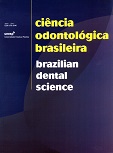Avaliação da proporção divina craniofacial antes e após tratamento ortodôntico, em fotografias e radiografias cefalométricas laterais
DOI:
https://doi.org/10.14295/bds.2011.v14i1/2.744Keywords:
Ortodontia, proporção divina, cefalometria, fotografia, estética.Abstract
Buscando a melhora e a individualização da análise cefalométrica na avaliação de indivíduos submetidos a tratamentoortodôntico, propôs-se, neste trabalho, avaliar a proporção divina em quatro razões cefalométricas e duas fotométricas. Aamostra foi composta por 42 indivíduos adultos, na faixa etária de 18 a 45 anos, sendo 21 de cada gênero, antes e após otratamento ortodôntico, utilizando-se radiografia cefalométrica lateral e fotografia lateral. As imagens radiográficas e asfotografias foram digitalizadas em 75 dpi com o auxílio de scanner conforme especificações da empresa que desenvolveuo software para cefalometria Radiocef Studio (Belo Horizonte, Minas Gerais, Brasil). Os pontos anatômicos foram marcadosduas vezes sobre a imagem digital radiográfica e fotográfica na tela do computador. A fim de verificar o erro intraexaminador, os dados foram submetidos à análise de regressão. Após a submissão dos dados aos testes estatísticos conclui-se que as quatro razões cefalométricas, antes e após o tratamento ortodôntico, não estavam, em média, em proporção divina. Porém, houve uma aproximação, em média, da proporção divina com o tratamento em Ena-Enp/V1S-C1MS, MdOr--POOr/POOr-MxOr e Me-Ena/Ena-N. As duas razões nas fotografias, antes e após o tratamento ortodôntico, estavam em proporção divina; uma delas, B-C/A-B, aproximou-se em média ainda mais da proporção divina após o tratamento. Houve diferença estatística entre B-C/A-B e MdOr-POOr/POOr-MxOr; A-C/A-D e Me-Ena/Ena-N, estando as duas razõesnas fotografias mais próximas da proporção divina antes do tratamento. Após o tratamento, somente a razão da fotografia A-C/A-D estava próxima da proporção divina.Downloads
Downloads
Published
How to Cite
Issue
Section
License
Brazilian Dental Science uses the Creative Commons (CC-BY 4.0) license, thus preserving the integrity of articles in an open access environment. The journal allows the author to retain publishing rights without restrictions.
=================




























